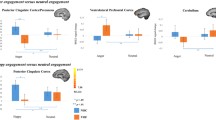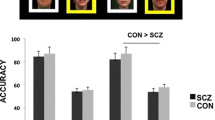Abstract
Reduced impulse control and emotion dysregulation are associated with an increased risk of violence in psychosis. We used an emotional stop-signal task (ESST) with angry and neutral facial expressions stimuli to examine the differences in inhibition in neutral and emotional contexts between acutely violent (N = 117) and non-violent (N = 50) patients with schizophrenia spectrum disorders and healthy volunteers (N = 50). However, 66 violent patients (56.41%) from the final sample with a higher level of self-reported impulsivity did not finish the behavioral task. Inhibition was found to be weaker in emotional than in neutral contexts in both the violent (n = 51) and non-violent patient groups in comparison with healthy controls. At the same time, violent patients had weaker inhibition in both neutral and emotional contexts than non-violent patients and healthy controls. Violent patients also showed significant associations between response inhibition and positive schizophrenia symptoms. These results show that emotion regulation impairment is present in schizophrenia patients in general and violent behavior is associated with higher impulsivity regardless of the emotional context. Impaired response inhibition seems to be a stronger indicator for violent patients than the disorder itself, and it may constitute a marker for the risk of violent behavior in psychotic patients. Positive symptoms might fall into underlying factors of increased impulsivity in acutely violent psychotic patients. However, the emotional stop-signal task seemed to be too strenuous for highly impulsive patients and acutely violent patients with psychosis, and its use was limited to the patients who were able or willing to complete the task.

Similar content being viewed by others
Data availability statement
The data that support the findings of this study are available from the first author, [VJ], upon reasonable request.
References
Bulgari, V., Bava, M., Gamba, G., Bartoli, F., Ornaghi, A., Candini, V., Ferla, M. T., Cricelli, M., Bianconi, G., Cavalera, C., Conte, G., Stefana, A., Picchioni, M., Iozzino, L., Crocamo, C., & Carrà, G. (2020). Facial emotion recognition in people with schizophrenia and a history of violence: A mediation analysis. European Archives of Psychiatry and Clinical Neuroscience, 270(6), 761–769. https://doi.org/10.1007/s00406-019-01027-8
Černý, M., Hodgins, S., Kučíková, R., Kážmér, L., Lambertová, A., Nawka, A., Nawková, L., Parzelka, A., Raboch, J., Bob, P., & Vevera, J. (2018). Violence in persons with and without psychosis in the Czech Republic: Risk and protective factors. Neuropsychiatric Disease and Treatment, 14, 2793–2805. https://doi.org/10.2147/NDT.S167928
Derntl, B., & Habel, U. (2017). Angry but not neutral faces facilitate response inhibition in schizophrenia patients. European Archives of Psychiatry and Clinical Neuroscience, 267(7), 621–627. https://doi.org/10.1007/s00406-016-0748-8
Egashira, K., Matsuo, K., Nakashima, M., Watanuki, T., Harada, K., Nakano, M., Matsubara, T., Takahashi, K., & Watanabe, Y. (2015). Blunted brain activation in patients with schizophrenia in response to emotional cognitive inhibition: A functional near-infrared spectroscopy study. Schizophrenia Research, 162(1-3), 196-204. https://doi.org/10.1016/j.schres.2014.12.038
Gur, R. C., Sara, R., Hagendoorn, M., Marom, O., Hughett, P., Macy, L., Turner, T., Bajcsy, R., Posner, A., & Gur, R. E. (2002). A method for obtaining 3-dimensional facial expressions and its standardization for use in neurocognitive studies. Journal of Neuroscience Methods, 115(2), 137–143. https://doi.org/10.1016/s0165-0270(02)00006-7
Habel, U., Chechko, N., Pauly, K., Koch, K., Backes, V., Seiferth, N., Shah, N. J., Stöcker, T., Schneider, F., & Kellermann, T. (2010). Neural correlates of emotion recognition in schizophrenia. Schizophrenia Research, 122(1–3), 113–123. https://doi.org/10.1016/j.schres.2010.06.009
Herbert, C., & Sütterlin, S. (2011). Response inhibition and memory retrieval of emotional target words: Evidence from an emotional stop-signal task. Journal of Behavioral and Brain Science, 01(03), 153–159. https://doi.org/10.4236/JBBS.2011.13020
Hoptman, M. J. (2015). Impulsivity and aggression in schizophrenia: A neural circuitry perspective with implications for treatment. CNS Spectrums, 20(3), 280–286. https://doi.org/10.1017/S1092852915000206
Kay, S. R., Fiszbein, A., & Opler, L. A. (1987). The positive and negative syndrome scale (PANSS) for schizophrenia. Schizophrenia Bulletin, 13(2), 261–276. https://doi.org/10.1093/schbul/13.2.261
Kay, S. R., Wolkenfeld, F., & Murrill, L. M. (1988). Profiles of aggression among psychiatric patients. I. Nature and prevalence. Journal of Nervous and Mental Disease, 176(9), 539–546. https://doi.org/10.1097/00005053-198809000-00007
Krakowski, M. I., De Sanctis, P., Foxe, J. J., Hoptman, M. J., Nolan, K., Kamiel, S., & Czobor, P. (2016). Disturbances in response inhibition and emotional processing as potential pathways to violence in schizophrenia: A high-density event-related potential study. Schizophrenia Bulletin, 42(4), 963–974. https://doi.org/10.1093/schbul/sbw005
Lindenmayer, J. P., Bernstein-Hyman, R., & Grochowski, S. (1994). A new five factor model of schizophrenia. The Psychiatric Quarterly, 65(4), 299–322. https://doi.org/10.1007/BF02354306
Lipszyc, J., & Schachar, R. (2010). Inhibitory control and psychopathology: A meta-analysis of studies using the stop signal task. Journal of the International Neuropsychological Society, 16(6), 1064–1076. https://doi.org/10.1017/S1355617710000895
Logan, G. D., & Cowan, W. B. (1984). On the ability to inhibit thought and action: A theory of an act of control. Psychological Review, 91(3), 295–327. https://doi.org/10.1037/0033-295X.91.3.295
Nichtová, A., Volavka, J., Vevera, J., Příhodová, K., Juríčková, V., Klemsová, A., Páv, M., Strunzová, V., Příhodová, T., Nocárová, M., Papoušková, E., Žižka, P., & Kališová, L. (2020). Deconstructing violence in acutely exacerbating psychotic patients. CNS Spectrums, 1–5. Advance online publication. https://doi.org/10.1017/S1092852920001601
Nolan, K. A., D’Angelo, D., & Hoptman, M. J. (2011). Self-report and laboratory measures of impulsivity in patients with schizophrenia or schizoaffective disorder and healthy controls. Psychiatry Research, 187(1–2), 301–303. https://doi.org/10.1016/j.psychres.2010.10.032
Nolan, K. A., Volavka, J., Czobor, P., Sheitman, B., Lindenmayer, J.-P., Citrome, L. L., McEvoy, J., & Lieberman, J. A. (2005). Aggression and psychopathology in treatment-resistant inpatients with schizophrenia and schizoaffective disorder. Journal of Psychiatric Research, 39(1), 109–115. https://doi.org/10.1016/j.jpsychires.2004.04.010
Patton, J. H., Stanford, M. S., & Barratt, E. S. (1995). Factor structure of the Barratt impulsiveness scale. Journal of Clinical Psychology, 51(6), 768–774. https://doi.org/10.1002/1097-4679(199511)51:6%3c768::aid-jclp2270510607%3e3.0.co;2-1
Pawliczek, C. M., Derntl, B., Kellermann, T., Kohn, N., Gur, R. C., & Habel, U. (2013). Inhibitory control and trait aggression: Neural and behavioral insights using the emotional stop signal task. NeuroImage, 79, 264–274. https://doi.org/10.1016/j.neuroimage.2013.04.104
Pessoa, L., Padmala, S., Kenzer, A., & Bauer, A. (2012). Interactions between cognition and emotion during response inhibition. Emotion, 12(1), 192–197. https://doi.org/10.1037/a0024109
Pinkham, A. E., Brensinger, C., Kohler, C., Gur, R. E., & Gur, R. C. (2011). Actively paranoid patients with schizophrenia over attribute anger to neutral faces. Schizophrenia Research, 125(2–3), 174–178. https://doi.org/10.1016/j.schres.2010.11.006
Seiferth, N. Y., Pauly, K., Kellermann, T., Shah, N. J., Ott, G., Herpertz-Dahlmann, B., Kircher, T., Schneider, F., & Habel, U. (2009). Neuronal correlates of facial emotion discrimination in early onset schizophrenia. Neuropsychopharmacology, 34(2), 477–487. https://doi.org/10.1038/npp.2008.93
Sheehan, D. V., Lecrubier, Y., Sheehan, K. H., Amorim, P., Janavs, J., Weiller, E., Hergueta, T., Baker, R., & Dunbar, G. C. (1998). The Mini-International Neuropsychiatric Interview (M.I.N.I.): The development and validation of a structured diagnostic psychiatric interview for DSM-IV and ICD-10. The Journal of Clinical Psychiatry, 59(Suppl 20), 22–57.
Stahl, S. M. (2014). Deconstructing violence as a medical syndrome: Mapping psychotic, impulsive, and predatory subtypes to malfunctioning brain circuits. CNS Spectrums, 19(5), 357–365. https://doi.org/10.1017/S1092852914000522
Verbruggen, F., Aron, A. R., Band, G. P., Beste, C., Bissett, P. G., Brockett, A. T., Brown, J. W., Chamberlain, S. R., Chambers, C. D., Colonius, H., Colzato, L. S., Corneil, B. D., Coxon, J. P., Dupuis, A., Eagle, D. M., Garavan, H., Greenhouse, I., Heathcote, A., Huster, R. J., Jahfari, S., … Boehler, C. N. (2019). A consensus guide to capturing the ability to inhibit actions and impulsive behaviors in the stop-signal task. eLife, 8, e46323. https://doi.org/10.7554/eLife.46323
Vercammen, A., Morris, R., Green, M., Lenroot, R., Kulkarni, J., Carr, V. J., Weickert, C. S., & Weickert, T. (2012). Reduced neural activity of the prefrontal cognitive control circuitry during response inhibition to negative words in people with schizophrenia. Journal of Psychiatry and Neuroscience, 37(6), 379–388. https://doi.org/10.1503/jpn.110088
Volavka, J., & Citrome, L. (2008). Heterogeneity of violence in schizophrenia and implications for long-term treatment. International Journal of Clinical Practice, 62(8), 1237–1245. https://doi.org/10.1111/j.1742-1241.2008.01797.x
Whiting, D., Gulati, G., Geddes, J. R., & Fazel, S. (2022). Association of schizophrenia spectrum disorders and violence perpetration in adults and adolescents From 15 countries: A systematic review and meta-analysis. JAMA Psychiatry, 79(2), 120–132. https://doi.org/10.1001/jamapsychiatry.2021.3721
Acknowledgements
This study was supported by the Ministry of Health of the Czech Republic grant number AZV 17-32445, by the Institutional Support Program “PRVOUK” registration number PRVOUK-P03/LF1/9, by the Ministry of Education, Youth and Sports of the Czech Republic – Specific University Research Project number MUNI/A/1385/2021, and by the Ministry of Health of the Czech Republic – Conceptual Development of Research Organization (‘FNBr, 65269705’).
Author information
Authors and Affiliations
Corresponding author
Ethics declarations
Conflicts of interest
The authors declare no conflicts of interest.
Additional information
Publisher's note
Springer Nature remains neutral with regard to jurisdictional claims in published maps and institutional affiliations.
Rights and permissions
Springer Nature or its licensor holds exclusive rights to this article under a publishing agreement with the author(s) or other rightsholder(s); author self-archiving of the accepted manuscript version of this article is solely governed by the terms of such publishing agreement and applicable law.
About this article
Cite this article
Juríčková, V., Linhartová, P., Adámek, P. et al. Behavioral inhibition in neutral and emotional contexts in acutely violent patients with schizophrenia spectrum disorders. Curr Psychol 42, 24088–24096 (2023). https://doi.org/10.1007/s12144-022-03415-1
Accepted:
Published:
Issue Date:
DOI: https://doi.org/10.1007/s12144-022-03415-1




